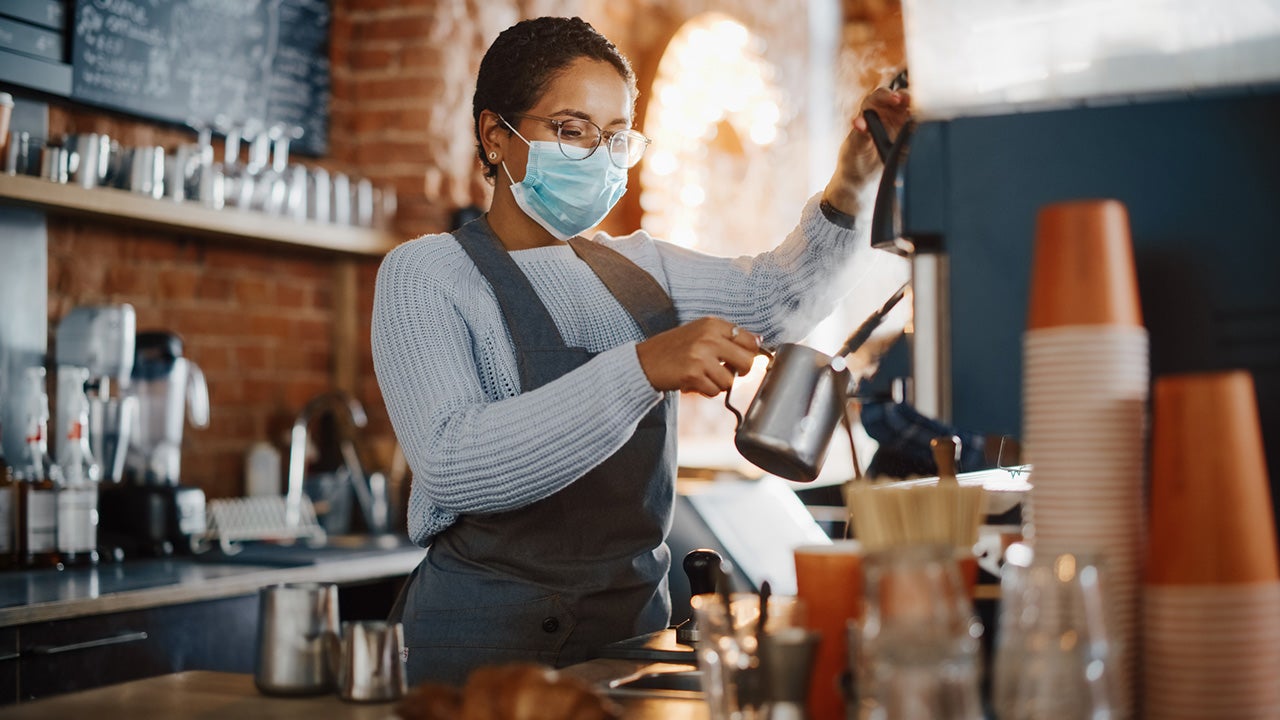For most of last year, many restaurants were closed or operating at minimal capacity due to local or state restrictions as rates of Covid-19 transmission stayed dangerously high. Income was down sharply. Then, as many states and cities reopened, restaurant operators had to deal with labor shortages and global supply chain issues. But help was at hand—vaccines became available. As warm weather arrived in 2021, restaurant operators and food workers looked forward to the long-delayed chance to regain lost income and welcome back the patrons they had missed.
Now they are experiencing a sense of déjà vu.
With the surge of the delta variant, restaurants face additional difficult issues as we head into winter. They must inoculate workers and deal with disruptions caused by staff contracting the virus and exposing others, both vaccinated and unvaccinated. A National Restaurant Association survey found that restaurants are in worse shape now than three months ago. And the stakes are high for workers who are already at higher risk.
Forty-nine percent of our nation’s food industry workers are Black/African American, Latino/a/x, and non-US-born individuals from Asian/Pacific Islander communities. These groups don’t have the luxury of stable jobs that can be done from home.
To make ends meet, they may need to hold multiple jobs, at riskier workplaces. If they are unfortunate enough to get sick, they are less likely to have access to quality care. As has been well documented during the pandemic, these populations face additional risks outside of the workplace, including bearing the heaviest burden of Covid-19 infection rates, experiencing limited access to testing and higher rates of serious illness and death.
There’s a way to help restaurants navigate their way through straits they didn’t expect to face again. Increasing partnership opportunities between these groups and their state and local public health officials can provide opportunities to prevent many problems that previously challenged restaurants and their workers.
Food industry workers provided essential services in the early days of the pandemic and continue to do so today. It was hard work before the pandemic, and it is even harder now. And their work remains essential to everyone. It’s the job of public health officials across the country to support and protect restaurant operators and food service workers during the ongoing pandemic—and they can, with some concrete action steps:
Support all eligible workers to get fully vaccinated, as well as receive a Covid-19 booster shot.
Now that booster shots are available for essential/frontline workers, food service workers and restaurant operators have an opportunity to receive the booster shot if it is their time. Additionally, health officials should also encourage owners and workers to get the annual influenza vaccine.
Work with restaurants to learn practical ways to supply as much fresh or filtered air as possible.
Many restaurants and other operations improved their ventilation over the last year, but with winter on the horizon and potentially fewer outdoor seating options, there are practical ways to improve ventilation that are not cost-prohibitive, such as keeping windows open when possible, ensuring HVAC systems are fully operational, cleaning filters (HEPA importantly), optimizing the number of air changes per hour, and incorporating plexiglass or polycarbonate cough and sneeze barriers.
Prepare restaurants to follow all local, state, and federal guidance.
This includes proof of vaccination for workers and diners, where allowed, as well as requiring masks at all times for workers and diners except when eating and drinking.
Encourage restaurant owners to screen all restaurant workers for Covid-19 symptoms every day.
Health officials can also educate workers about the need to stay home and get tested for Covid-19 when feeling ill. These actions as well as owners providing paid sick leave for workers who have symptoms or have been exposed are important elements in reducing the spread of Covid-19 in the workplace.
All of these actions will require open communication and, in some instances, a bit of training. Importantly, restaurants need to know that they have a partner in their local health department. Health officials locally can help food service workers and restaurant operators find vaccines and provide plain language, high-quality information on vaccination for Covid-19 and the flu.
That’s why the CDC Foundation has partnered with Food & Society at the Aspen Institute and the Kresge Foundation to release a new video online training specifically designed for health officials across the country, based on Food & Society’s comprehensive Covid-19 guidelines, Safety First: Protecting Workers and Diners as Restaurants Reopen and designed by the Public Health Foundation, a leading national designer of training materials for health care professionals.
For many of us, it was painful to see so many restaurants close over the last year and a half due to the consequences of the pandemic. They were often the first to close and last to reopen. It’s vital we protect our food service workers and stop the spread of Covid-19 so we can help our restaurants stay open. This will keep our neighborhoods vibrant, our cities thriving, and our communities healthy.
Judy Monroe, MD, is president and CEO of the CDC Foundation and former state health commissioner for Indiana. Corby Kummer is executive director of the Food and Society policy program at the Aspen Institute and a senior editor at The Atlantic.


